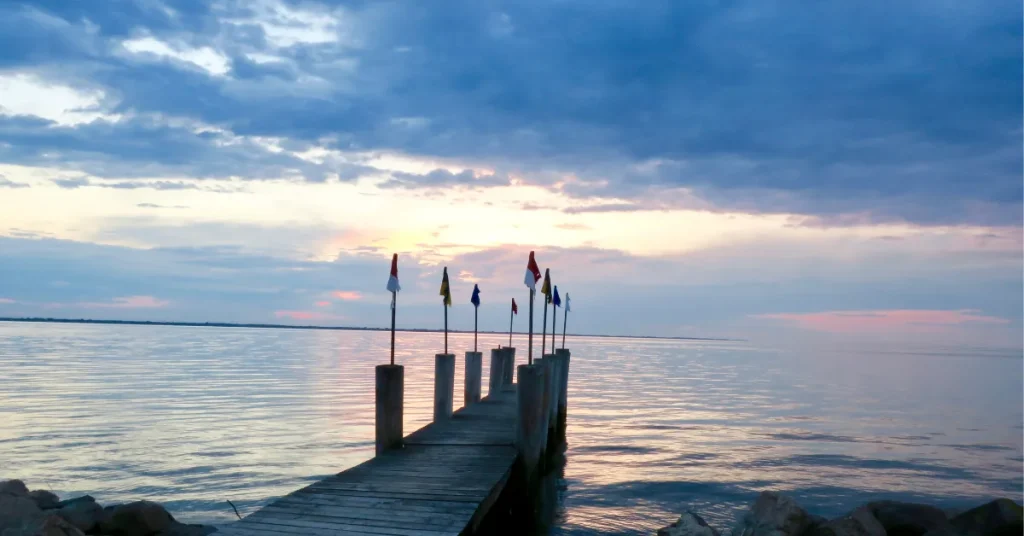Lake Winnebago in Wisconsin has a maximum depth of approximately 21 feet. The average depth of the lake is around 15 feet.
Nestled in the heart of Wisconsin, Lake Winnebago is the state’s largest inland lake, spanning an impressive 137,700 acres. It stands as a natural reservoir for the Fox and Wolf Rivers and is a vital resource for local communities.
Anglers and recreational boaters flock to Lake Winnebago for its abundant fishing opportunities and pleasant boating conditions.
The lake’s relatively shallow depths create an ideal environment for a robust fish population, making it a hotspot for walleye, perch, and sturgeon fishing.
Year-round, visitors and residents enjoy the scenic beauty and the recreational activities Lake Winnebago has to offer, solidifying its status as a Wisconsin treasure.

Exploring Lake Winnebago’s Mysteries
Lake Winnebago is not just Wisconsin’s largest inland lake. It’s a natural wonder, teeming with secrets beneath its waters. With rich history and vibrant culture, the lake is a centerpiece for both recreation and tradition.
Let’s dive into the depths of Lake Winnebago and discover what makes it so captivating.
Geographical Position And Significance
Nestled in East-Central Wisconsin, Lake Winnebago boasts a prime location that’s hard to miss.
- Length: 30 miles
- Width: 10 miles
- Surface Area: 215 square miles
This makes it the state’s largest lake by surface area.
With shallow depths averaging 15 feet and reaching up to 21 feet at its deepest, Lake Winnebago is relatively shallow. Its depth is vital for various species of fish and waterfowl that inhabit it.
Historical Background And Cultural Importance
Lake Winnebago’s history is as deep as its waters. The lake has seen centuries of Native American heritage, early European exploration, and continued local celebration.
Indigenous tribes once thrived on the lake’s bounty, leaving behind a tapestry of archaeological significance. In the mid-1600s, European explorers laid eyes on its vast expanse, marking a turning point in its story.
Today, Lake Winnebago’s culture is a blend of past and present. Annual events like the Walleye Weekend fishing festival and ice fishing sturgeon spearing season draw crowds from near and far, celebrating not just the catch, but a way of life.
Its role in trade, transportation, and as a living museum make Lake Winnebago a cornerstone of local identity.
Measuring The Depths
Exploring Lake Winnebago’s depths excites both the curious traveler and the scientific community. Beneath its placid surface, the lake holds secrets that depth measurements reveal.
Techniques Used For Depth Measurement
Several advanced techniques help us understand Lake Winnebago’s underwater topography.
- Echo sounding: Uses sound waves to find the lake’s deepest points.
- GPS mapping: Combines Echo sounding data with GPS for accuracy.
- Sonar technology: Offers detailed images of the lake bed.
These methods provide a clear picture of depths, contours, and structures.
Challenges In Depth Determination
Determining Lake Winnebago’s depth comes with unique challenges.
- Water level fluctuations: Change with weather and seasons, affecting depth.
- Sedimentation: Sediments shift, altering the bottom profile.
- Submerged objects: Can interfere with depth measurement tools.
Careful data analysis helps overcome these obstacles, giving accurate depth readings.
Lake Winnebago’s Depths Revealed

Peering into the watery depths of Lake Winnebago, we uncover a world that few may realize exists beneath the gentle waves.
This vast body of water holds secrets and surprises that can amaze both locals and visitors alike. Let’s dive into the details and discover just how deep Lake Winnebago really is with some intriguing comparisons.
Average And Maximum Depth Figures
Lake Winnebago may not be the deepest among its peers, but its measurements are still impressive. Boasting a more modest stature, this lake has depths that remain a wonder to explore.
| Depth Details of Lake Winnebago | |
| Average Depth: | 15.5 feet |
| Maximum Depth: | 21 feet |
When viewed against the backdrop of this expansive lake, these figures invite us to appreciate its unique character.
Comparison With Other Great Lakes
Size isn’t everything, and when it comes to depth, Lake Winnebago stands in gentle contrast to its larger cousins, the Great Lakes.
- Lake Winnebago’s modest 21 feet pales in comparison to Lake Superior’s staggering 1,332 feet.
- Even Lake Erie, the shallowest of the Great Lakes, demonstrates a considerable 210 feet at its deepest point.
These differences in depth craft unique environments both above and below the surface, making Lake Winnebago a special place in its own right.
The Ecological Wonders Below The Surface
Lake Winnebago’s depths hide a diverse world teeming with life, each element specially adapted to thrive beneath its waters.
Here, we’ll delve into the underwater marvels of this ecological treasure and explore how its depth shapes life forms and impacts the local fishing industry and ecosystems.
Adaptations Of Aquatic Life To Depth
The fascinating creatures of Lake Winnebago have evolved in incredible ways to survive at various depths. Here are some adaptations:
- Scale coloring helps fish blend with the dark waters.
- Gill size variation allows efficient oxygen use.
- Swim bladders aid in buoyancy control for depth changes.
- Pressure-resistant bodies endure the increasing depth.
- Low-light vision enables navigation in murky depths.
Inhabitants like the cisco and the sturgeon showcase such amazing traits. These adaptations are key for their survival in Lake Winnebago’s variable depths.
Impact On Fishing And Local Ecosystems
Lake Winnebago’s depths directly influence fishing practices and ecosystem health:
| Aspect | Impact |
| Depth diversity | Creates rich fishing spots and diverse habitats. |
| Temperature layers | Affects fish movement and feeding patterns. |
| Oxygen levels | Influences fish health and species distribution. |
Due to these impacts, anglers are drawn to the lake, supporting a vibrant fishing economy. Conservation efforts ensure the lake’s health, benefiting all who rely on its bounty.
Human Interactions With Lake Winnebago
Lake Winnebago is a gem nestled in Wisconsin, US. Families and adventurers alike flock here to enjoy its natural beauty.
The lake’s shallow depth, averaging about 15.5 feet with a maximum depth of roughly 21 feet, makes it perfect for various activities. Let’s dive into how its depth shapes human interactons.
Recreational Activities Influenced By Depth
Lake Winnebago’s shallow waters provide a safe haven for family fun and sporting adventures. Here’s how its depth impacts recreation:
- Boating: Its vast surface and moderate depth make it ideal for sailing and motorboating.
- Fishing: Walleye and sturgeon thrive in these conditions, attracting anglers year-round.
- Swimming: Gently sloping beaches and warm, shallow areas are perfect for swimmers.
- Ice Fishing: The lake freezes uniformly due to its shallowness, enabling this winter sport.
Conservation Efforts And Water Quality Initiatives
Protecting Lake Winnebago is vital. Conservation groups work tirelessly to preserve its health. Key initiatives include:
- Water Clarity Programs: These aim to increase visibility and reduce pollutants.
- Erosion Control Measures: Steps to prevent shoreline degradation are critical.
- Habitat Restoration: Efforts to maintain the lake’s diverse ecosystem take precedence.
- Community Outreach: Education on responsible use helps safeguard the lake for future generations.
The Future Of Lake Winnebago’s Depths

Exploring Lake Winnebago’s future depths opens a window into understanding how this treasured lake might change. Lake Winnebago’s current depths reveal much about its past and present. Yet, it’s the future that stirs curiosity and concern.
Climate Change And Its Impact On Water Levels
Climate change holds a significant role in altering water levels in lakes worldwide. With rising temperatures, Lake Winnebago faces potential impacts that could reshape its depths.
- Ice cover decreases leading to more evaporation.
- Extreme weather patterns cause fluctuating water levels.
- Warming temperatures can affect fish habitats and water quality.
Scientific And Environmental Predictions
Scientists continuously work to predict changes in Lake Winnebago’s ecosystem.
- Studies focus on water depth measurement using advanced technology.
- Environmental models estimate how the lake will respond to various scenarios.
Efforts to preserve Lake Winnebago rely on accurate predictions and sustainable practices. With ongoing research and community involvement, we can hope to maintain the lake’s health and natural beauty for future generations.
FAQs About How Deep Is Lake Winnebago
What Is The Maximum Depth Of Lake Winnebago?
Lake Winnebago, located in Wisconsin, has a maximum depth of approximately 21 feet. This relatively shallow depth is consistent throughout much of the lake.
How Does Lake Winnebago’s Depth Compare To Other Lakes?
While Lake Winnebago is Wisconsin’s largest inland lake, it’s not the deepest. In comparison, Wisconsin’s Green Lake reaches depths of 237 feet, making Lake Winnebago much shallower.
What Are The Average Depths Across Lake Winnebago?
The average depth of Lake Winnebago hovers around 15 feet. Although the maximum depth is 21 feet, most areas of the lake maintain this shallower average.
Does Lake Winnebago’s Depth Impact Its Fishing?
Yes, Lake Winnebago’s depth influences its fish species and behaviors. The shallowness supports abundant aquatic plants and therefore, a healthy fish population, making it a popular fishing destination.
Conclusion
Exploring the depths of Lake Winnebago has revealed its varied underwater landscapes. Averaging 15 feet and reaching depths of 21 feet, this lake offers diverse aquatic environments.
For anglers and explorers alike, its depth is a treasure trove that promises adventure and discovery.
So, next time you visit, remember the wonders beneath your boat.
Resources:
1. https://apps.dnr.wi.gov/lakes/lakepages/LakeDetail.aspx?wbic=131100
